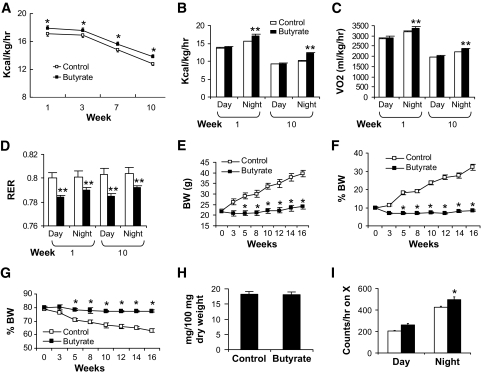FIG. 1.
Energy metabolism in response to sodium butyrate. Butyrate increased energy expenditure in C57BL/B6 mice. Energy expenditure was examined using the metabolic chamber at the 1st week and the 10th week on high-fat diet (16 weeks in age). In this study, sodium butyrate was used at 5% wt/wt in high-fat diet. A: Food intake. Food intake was monitored daily for 5 days at each time point. Average daily food intake (g) was converted into kilocalories and normalized with body weight (kg) and 24 h. B: Energy expenditure measured as kilocalories per kilogram lean mass per hour. C: Oxygen consumption measured as milliliters volume oxygen per kilogram lean mass per hour. D: Substrate utilization. This is expressed by respiratory exchange ratio (RER), which is the volume ratio of oxygen consumed versus CO2 exhaled. E: Body weight (BW). F: Body fat content in percentage of body weight. This was determined by nuclear magnetic resonance. G: Body muscle content in percentage of body weight. H: Lipid in feces. Feces were collected in the cages during a 24-h period on high-fat diet at 12 weeks. Total lipids were extracted and quantified (P > 0.05, n = 5). I: Spontaneous physical activity. The frequency of horizontal movement (X) was shown for day and night at 10 weeks on a high-fat diet. For A–D, and I, n = 8 in the control or butyrate group. For E–G, n = 10 in the control or butyrate group. Values are the means ± SE. *P < 0.05, **P < 0.001 by Student's t test. □, Control; ■, butyrate.

